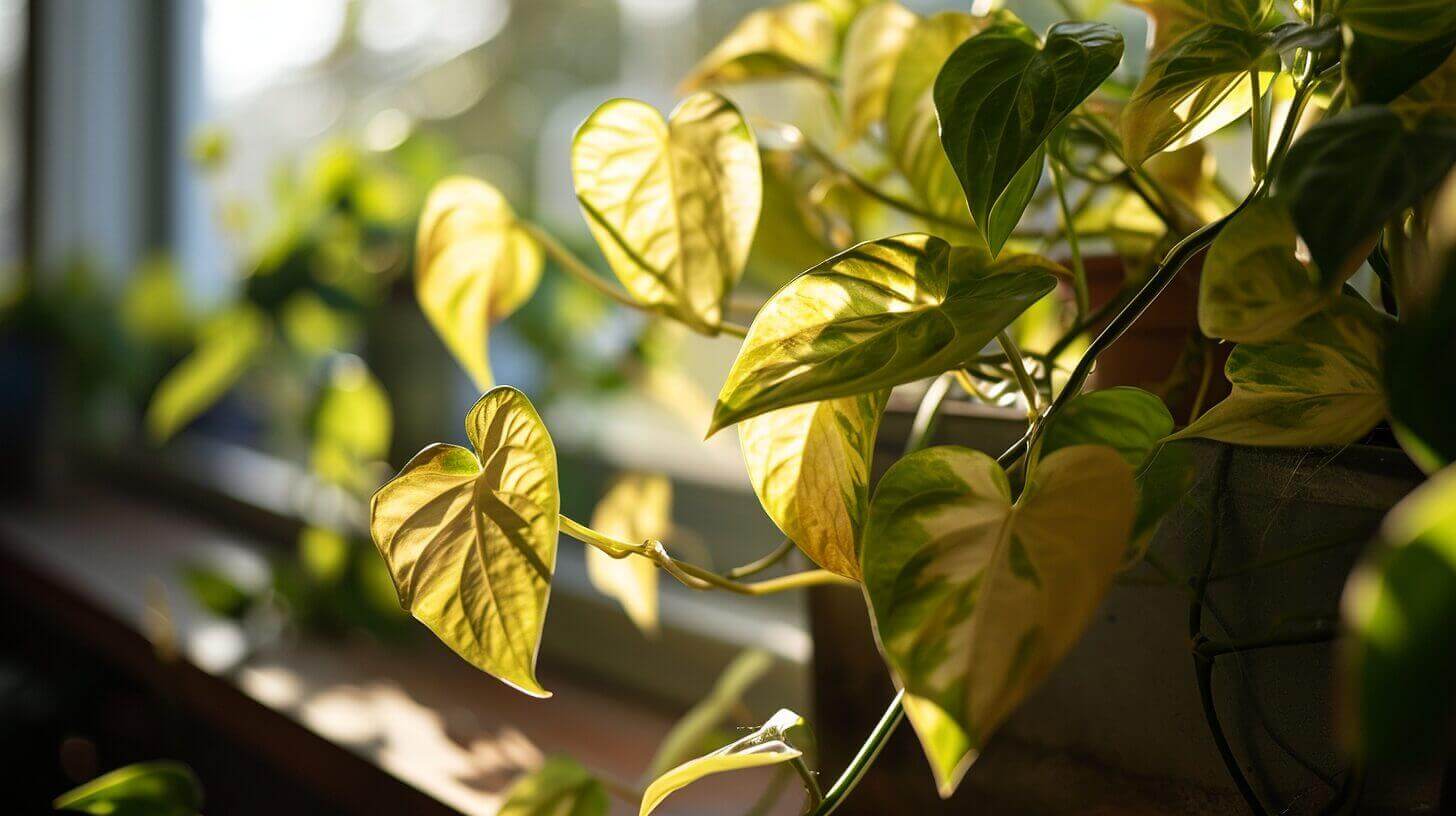Why Your Pothos Leaves Turning Yellow and How to Fix It
Like the vibrant colors of a summer sunrise, the lush green leaves of a healthy pothos plant bring life and beauty to any space.
But what happens when those leaves start to turn yellow, signaling a problem beneath the surface?
In this informative and practical article, we will explore the common causes of yellowing pothos leaves, from nutritional deficiencies to overwatering.
Armed with this knowledge, you will be equipped to restore your pothos to its former glory and ensure its continued vitality.
Key Takeaways
- Overwatering can cause root rot and nutrient deficiencies, leading to yellowing leaves.
- Insufficient sunlight exposure can contribute to nutrient imbalances and yellowing leaves.
- Conducting a soil test can help identify nutrient deficiencies or imbalances.
- Proper watering, adequate sunlight, targeted supplementation, and addressing pests and diseases are key to restoring greenery to your Pothos plant.
Common Causes of Yellow Pothos Leaves
One of the most common causes of yellowing pothos leaves is overwatering, as excessive moisture can lead to root rot and nutrient deficiencies. Pothos plants are relatively easy to care for, but they do require the right balance of water and nutrients to thrive. When the soil is consistently wet, the roots become suffocated and can no longer absorb nutrients properly. This imbalance can result in yellowing leaves.
To prevent overwatering, it’s important to allow the soil to dry out between waterings. Pothos plants prefer to be slightly dry before watering again. Additionally, make sure your pothos is receiving adequate sunlight exposure. While they can tolerate low light conditions, they thrive in bright, indirect light. Insufficient sunlight can also contribute to nutrient imbalances and yellowing leaves.
When addressing nutrient deficiencies, it’s helpful to use a balanced, water-soluble fertilizer specifically formulated for houseplants. Follow the instructions on the label and apply the fertilizer during the growing season. This will provide the necessary nutrients to promote healthy foliage and prevent yellowing.
Understanding Nutritional Deficiencies in Pothos Plants
To address nutritional deficiencies in pothos plants, it is important to identify the specific nutrient needs and provide adequate supplementation. Nutrient imbalances can lead to yellowing leaves and overall poor plant health. Here are some key points to consider when managing the nutritional needs of your pothos:
- Understand the specific nutrient requirements: Pothos plants require a balanced supply of essential macronutrients such as nitrogen, phosphorus, and potassium, as well as micronutrients like iron, magnesium, and manganese.
- Conduct a soil test: Before supplementing nutrients, it is crucial to test the pH and nutrient levels in the soil. This will help you determine any deficiencies or imbalances that need to be addressed.
- Adjust soil pH: Pothos plants thrive in slightly acidic to neutral soil pH levels (around 6.0-7.0). If your soil is too alkaline or acidic, it can affect nutrient availability. Use appropriate soil amendments or pH adjusters to bring the pH within the desired range.
- Provide targeted supplementation: Once you have identified nutrient deficiencies, provide appropriate supplementation. This can be done through organic fertilizers or water-soluble fertilizers specifically formulated for indoor plants. Follow the instructions on the packaging for application rates and frequency.
Overwatering: A Potential Culprit Behind Pothos Leaves Turn Yellow
The article discusses how overwatering can be a potential culprit behind yellow leaves in pothos plants. Overwatering is a common mistake that many plant owners make, often with good intentions of providing adequate hydration. However, excessive water can lead to root rot and nutrient deficiencies, resulting in yellowing leaves.
One of the signs of overwatering in pothos plants is yellowing leaves that are soft and mushy to the touch. This is a clear indication that the roots are being suffocated by excess water, preventing them from absorbing nutrients properly. In addition to yellow leaves, you may also notice wilting, drooping, or even blackened roots.
Preventing overwatering is crucial for the health of your pothos plant. First, ensure that you are using well-draining soil and a pot with drainage holes to allow excess water to escape. It’s important to water your pothos plant only when the top inch of soil feels dry to the touch. Be mindful not to overwater, as it is better to slightly underwater than to drown the roots.
Pests and Diseases: Identifying and Treating Yellowing Leaves on Pothos
Interestingly, yellowing leaves in pothos plants can also be caused by pests and diseases, requiring careful identification and treatment to ensure the plant’s health and vitality. Here are some common pests and diseases that can lead to yellowing leaves in pothos plants, along with effective treatment methods:
- Aphids: These tiny insects can suck the sap from pothos leaves, causing them to yellow and wilt. To get rid of aphids, spray the affected leaves with a mixture of water and mild liquid soap.
- Spider mites: These pests are known for their web-like structures on the leaves of plants. They can cause yellowing and discoloration. Regularly misting the leaves with water can help prevent spider mites, and if they are already present, use an insecticidal soap or neem oil to eliminate them.
- Root rot: Overwatering and poor drainage can lead to root rot, which can cause yellowing leaves. To treat root rot, remove the affected parts of the plant and repot it in fresh, well-draining soil.
- Fungal diseases: Diseases like powdery mildew and leaf spot can cause yellowing and spotting on pothos leaves. Treating these diseases often involves removing affected leaves and applying a fungicide according to the instructions on the label.
Practical Tips for Restoring Greenery to Your Pothos Houseplant
After identifying and treating the pests and diseases causing yellowing leaves in your pothos, now is the time to implement practical tips for restoring greenery to your plant. Restoring vitality and promoting growth in your pothos requires a combination of proper care and attention to its needs.
First and foremost, ensure that your pothos is receiving adequate sunlight. Pothos plants thrive in bright, indirect light, so placing them near a north or east-facing window is ideal. If natural light is limited, you can also supplement with artificial grow lights.
Next, pay attention to watering. Overwatering can lead to root rot, while underwatering can cause stress and yellowing of the leaves. Water your pothos thoroughly, allowing excess water to drain away, and then wait until the top inch of soil feels dry before watering again.
In addition to proper lighting and watering, it’s important to provide your pothos with a balanced fertilizer. A slow-release fertilizer or a diluted liquid fertilizer can help replenish the nutrients in the soil and promote healthy growth.
Lastly, make sure to keep an eye out for pests and diseases. Regularly inspect your plant for signs of infestation and take appropriate measures to address any issues promptly.
Frequently Asked Questions
Can Making a Pothos Bushy Help Prevent its Leaves from Turning Yellow?
Can making a Pothos bushy help prevent its leaves from turning yellow? Implementing optimal strategies for pothos’ bushiness can indeed contribute to mitigating this issue. By encouraging proper growth through regular pruning, providing ample sunlight, and providing adequate water and nutrients, the plant’s overall health can be improved, potentially helping to prevent yellowing leaves.
Is It Normal for Pothos Turning Yellow During the Winter Months?
During the winter months, it is not uncommon for pothos leaves to turn yellow. This can be attributed to a variety of factors, such as reduced sunlight and lower temperatures.
However, there are steps you can take to prevent yellowing leaves in your pothos plants. By ensuring they receive adequate light and maintaining a consistent temperature, you can help keep the leaves healthy and green.
Additionally, avoiding common mistakes like overwatering or using improper soil can also contribute to leaf discoloration.
Are There Any Specific Pests or Diseases That Commonly Affect Pothos Plants and Cause Yellowing Leaves?
Pothos plants are commonly affected by a variety of pests and diseases that can cause the leaves to turn yellow.
Some common pests include spider mites, mealybugs, and aphids. These pests can be controlled with natural remedies such as neem oil or insecticidal soap.
As for diseases, root rot and fungal infections can also lead to yellowing leaves. Proper watering and ensuring good drainage can help prevent these issues.
Why are the leaves on my pothos turning yellow?
There can be several reasons why your pothos leaves are turning yellow. One common cause is overwatering. Pothos plants like to be kept slightly moist, but if they are receiving too much water, the roots can become saturated and lead to yellowing leaves. Another possible reason is underwatering. If the plant is not receiving enough water, the leaves may start to turn yellow and fall off. Additionally, if your pothos is exposed to direct sunlight for long periods of time, it can cause the leaves to yellow. Finally, nutrient deficiencies or improper plant care can also result in yellow leaves on your pothos.
What are the causes of pothos leaves turning yellow and brown?
Pothos leaves turning yellow and brown can be caused by various factors. Overwatering is a common cause, as it can lead to root rot and the development of brown spots on the leaves. Underwatering can also cause the leaves to turn yellow and brown. Exposure to extreme temperatures or drafts can also result in leaf discoloration. Finally, nutrient deficiencies or pests can contribute to the yellowing and browning of pothos leaves.
How much water does a pothos plant need?
Pothos plants prefer to be kept slightly moist, but not soggy. It is important to allow the top inch of soil to dry out between waterings. This allows the roots to receive sufficient oxygen and helps prevent overwatering. However, it’s important not to let the soil completely dry out, as this can lead to leaf wilting and yellowing.
Will Proper Watering Help Prevent Pothos Leaves from Turning Yellow?
Watering Pothos regularly and adequately is crucial to prevent its leaves from turning yellow. The improper water supply can lead to over or under-watering, causing stress to the plant. Maintain the soil moisture by checking the top inch and watering when it feels slightly dry. Proper watering is essential for maintaining healthy and vibrant Pothos foliage.
Why do the leaves on my pothos turn yellow after repotting?
It is not uncommon for the leaves on a pothos plant to turn yellow after repotting. This is often due to the stress the plant experiences during the repotting process. It may take a few weeks for the plant to adjust to its new environment and for new leaves to grow. Provide proper care, including adequate watering and light, and the plant should recover and produce healthy leaves.
What are the reasons why pothos leaves turn yellow?
There are several reasons why pothos leaves may turn yellow. Overwatering, underwatering, exposure to direct sunlight, nutrient deficiencies, and improper plant care are some common factors. Additionally, repotting can sometimes cause temporary leaf yellowing. By understanding and addressing these factors, you can prevent and fix yellow leaves on your pothos plant.







